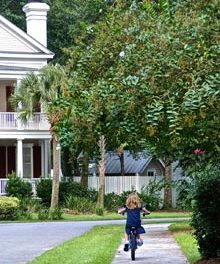The conversion from rail to trail is a process typically led by advocacy groups which secure funding from various sources, ranging from private donations to foundation contributions to government grants. The conversion process involves land acquisition, rail removal, trail creation, and landscaping. Depending on the size of the trail and the monies available, these projects tend to be phased. The Beaufort County Rail Trail, a.k.a. the Spanish Moss Rail Trail, effort is being lead by the Friends of the Rail Trail.
Rail trails are often touted by supporters to be transformational assets that can attract tourist dollars, instigate redevelopment, and enhance community facilities. They are also panned by critics who cite cost overruns and overstretched maintenance issues. But what is the track record on rail trails? Are they community assets or economic boondoggles? What can Beaufort County learn from others?
The Camden County Experience
Not all Rail Trails are immediately successful. One hundred miles down the coast from Beaufort is Camden County, Georgia. The county is similar to ours, with a coastal landscape penetrated by marshes and shaded by live oaks. While Camden County is smaller and less prosperous than Beaufort County, one thing it accomplished before this region is the conversion of its abandoned railroad line to a rail trail.
The trail opened in 2010, and so far, it’s not doing as well as the region would like. What Camden County discovered was that rail trails cost money – a LOT of money – to run. Funding sources that are secured for the conversion process oftentimes do not adequately support the trails after the bulldozers and work crews leave the site. Camden County now spends over half of its parks budget on maintaining three miles of the rail trail, at the expense of other park facilities. The economic benefits that the rail trail was supposed to provide have not come to full fruition. Beyond Camden County, there have been lawsuits in communities across the country due to the inability for advocacy groups to adequately maintain their trails.
The Pinellas County Experience
With the hard lessons learned by Camden County and other jurisdictions, one might ask: Does this mean that rail trails are not worth the investment? NOT AT ALL!
In suburban areas of Tampa, Florida, the 37-mile Pinellas Trail has been a smashing success, with an estimated usage of over 1.2 million people per year. Communities on the trail such as Clearwater, Dunedin, and Largo have fully embraced the Pinellas Trail, showing it off as a major asset for downtown investment and a quality of life attractor.
The economics of the area suggest the rail trail had a very positive influence. According to the Environmental News Service, vacancy rates in downtown Dunedin were over 30 percent prior to the trail’s opening. After the trail opened in 1991, the additional presence of people in downtown motivated city leaders to invest in streetscape improvements that created an attractive destination, not only for trail users, but also for businesses. Today, Dunedin’s vacancy rate is in single digits, even in a tough economic environment.
The Path Ahead
So, what are some lessons that Beaufort County might learn, as we begin to create our own rail trail? Here are some observations from the Pinellas Trail and other successful projects around the world:
- Begin and end the trail someplace interesting and connect it with attractive places in between.
- Increase trail usage by providing multiple and easy-to-find access points.
- Capitalize on existing landscaping and attractive areas to lower landscaping costs.
- Connect the rail trail with important redevelopment efforts (for example – former Port property in Port Royal).
- Pave major portions of the trail. The most successful rail trails are “all-weather” and allow for a multitude of users, such as walkers, runners, bikers, and roller skaters.
- Ensure that removal of railroads does not hinder other business opportunities.
The last point is arguably the worst problem that Camden County faces today in that there is no longer any rail access at all. The loss of rail access creates a significant handicap for the county’s ability to recruit certain types of business. This is quite critical for Beaufort County as well. Since the rails have been removed over a span of 20 miles from Port Royal to Trask Parkway, with the potential to go even further into Yemassee, we have to ensure that the land around the trail can function at its best and highest use. As aforementioned, rail trails have the potential to increase value in the areas they impact. Cooperation between the rail trail and the adjacent property and business owners is crucial to encourage this positive effect.
As the Pinellas Trail shows, rail trails have the potential to increase value in the areas they impact, but it takes commitment and community support. So far, the Friends of the Rail Trail have done a great job garnering this support and raising awareness about the benefits of the Spanish Moss Trail. The trail’s continued success will depend on the factors outlined above and the willingness for project stakeholders to all be on the same track.
This article was written for Lowcountry Weekly by the Congress for the New Urbanism – Carolinas Chapter. For more info, visit www.cnu.org









